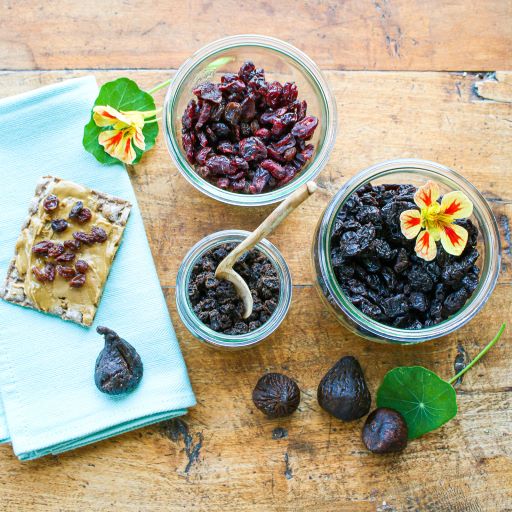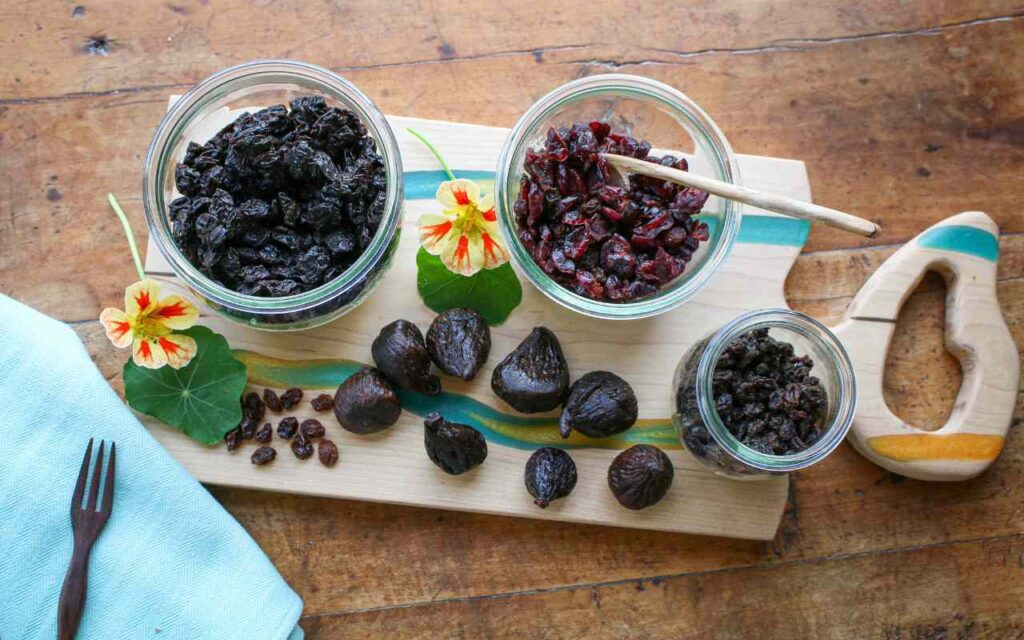
Wondering about the healthiest dried fruit, freeze dried fruit, and how to use more mixed dried fruit in your balanced diet? I’m answering your top questions and sharing recipes on how to use dried fruit, especially when fresh fruits are not as available.
The summer fruit season is short and intense, when fresh fruits, such as peaches, apricots, berries, plums, and grapes first appear. Indeed, these are precious gems of the season, but they seem to vanish as quickly as they arrive. Fortunately, a variety of dried fruit is available all year long, offering a sustainable, seasonal, and healthful alternative for fresh forms when the summer season subsides. That’s why it’s a great idea to take advantage of dried fruit, especially in the winter, but even all year long.

Healthiest Dried Fruit
I’m a big advocate of consuming more whole fruits, as these plant-based gifts from nature are packed with unique nutrients linked with health protection. Fruits contain rich stores of vitamins A, C, and K, fiber, manganese, potassium, copper, and a variety of phytochemicals linked with health protection. These phytochemicals are rich in antioxidant and anti-inflammatory properties. No wonder studies link fruit consumption with lower risk of chronic diseases.

Is Dried Fruit Healthy, and is Freeze Dried Fruit Healthy?
Dried fruit and freeze dried fruit are a healthy alternative to fresh fruit. If they are made without added sugars, these dried fruits are considered a low-sugar addition to your day. They are also concentrated in some nutrients, such as fiber, iron, and potassium. But dried fruit are also more dense in calories, because water is removed. So the standard portion for dried fruit is about 1/4 cup per serving. Look for dried fruit that does not have added sugars are unwanted ingredients. You can also prioritize organic dried fruit to ensure lower pesticide residues are present.

I’m a big advocate of consuming more whole fruits, as these plant-based gifts from nature are packed with unique nutrients linked with health protection. Fruits contain rich stores of vitamins A, C, and K, fiber, manganese, potassium, copper, and a variety of phytochemicals linked with health protection. These phytochemicals are rich in antioxidant and anti-inflammatory properties. No wonder studies link fruit consumption with lower risk of chronic diseases.
Dried fruit is a more seasonal, sustainable offering during the off-season, helping you to limit the number of miles your produce travels to you in the cooler months. They can also help you reach the recommended one to two cups of fruit a day for optimal health.

How to Make Dried Fruit?
Drying fruit removes water, which makes fruit shelf-stable, and produces a rich, sweet flavor, while concentrating some nutrients, such as fiber, iron, and potassium. What is freeze dried fruit? This type of preserved fruit follows a different journey to drying; these fresh fruits are first frozen, then placed in a vacuum under low pressure to remove water. You can dry your own fruit at home by placing it on sheets in the sun or in a low temperature oven until the fruit becomes dried. Then store in air-tight container bags. Learn more about home drying fruit from the USDA here.

Dried Fruit List
Look for the following commonly found dried fruit and freeze dried fruit forms in your supermarket:
Apples
Apricots
Bananas
Cherries
Citrus
Cranberries
Currants
Figs
Goji Berries
Mango
Papaya
Peaches
Pears
Pineapple
Prunes
Raisins

So, look for dried fruit as a delicious way to get your daily dose of fruits, and check out my top 4 tips for powering up on dried fruit.
Power Up on the Healthiest Dried Fruit

1. Top Your Cereal
Add the flavor and nutrition power of dried fruits to your favorite cereal recipes, such as oats, porridge bowls, and whole grain cold cereal. This strategy can boost natural sweetness, thus reducing added sugar. Plus it’s easy—no peeling or chopping required.

2. Toss Dried Fruits into Your Salads
Nothing quite matches the naturally sweet flavor and crunchy texture of dried fruits in your salads. Numerous forms of dried fruits complement green, grain, fruit, and vegetable salads, such as dried apricots, dates, cranberries, prunes, and raisins.

3. Sweeten Up Your Desserts
Don’t forget to lend a healthy sweet touch to your desserts, compliments of dried fruits. They are excellent added to cookies, compotes, crumbles, pies, and cakes. Pack in a serving of fruit, and cut down on sugar intake by stirring in dried fruits.

4. Mix Up Your Own Dried Fruit and Nut Mix
A handful of dried fruits is one of your best options for a healthful snack, such as this hand-made trail mix recipe (featured in the image above and the video here). They are shelf-stable, hardy (they won’t get squashed in your bag!), and easy to pack along everywhere.
For other recipes featuring dried fruits, try some of my favorites:
Blueberry Millet Muffins
Cranberry Jalapeno Hummus
Butternut Squash Kale Barley Salad
Crunchy Cherry Sunflower Seed Wraps
Vegan Overnight Oats with Figs and Walnuts
This post may contain affiliate links. For more information click here.
